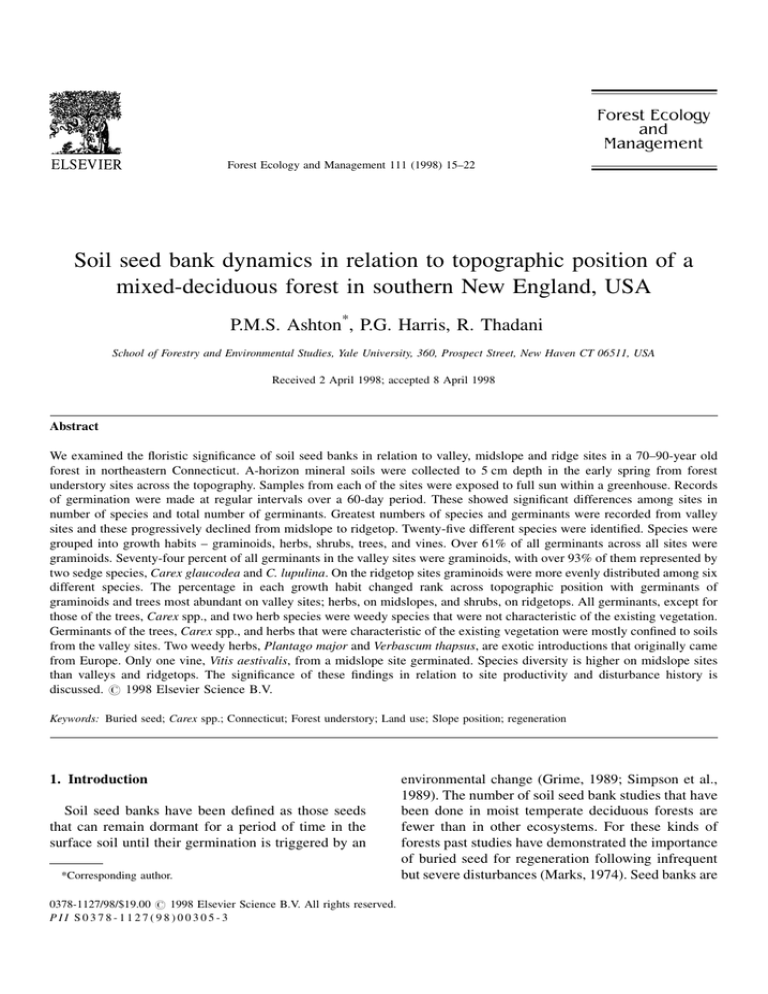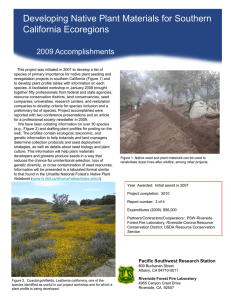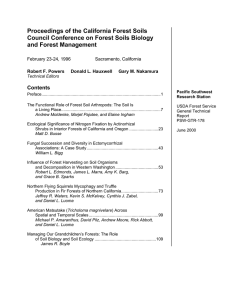
Forest Ecology and Management 111 (1998) 15±22
Soil seed bank dynamics in relation to topographic position of a
mixed-deciduous forest in southern New England, USA
P.M.S. Ashton*, P.G. Harris, R. Thadani
School of Forestry and Environmental Studies, Yale University, 360, Prospect Street, New Haven CT 06511, USA
Received 2 April 1998; accepted 8 April 1998
Abstract
We examined the ¯oristic signi®cance of soil seed banks in relation to valley, midslope and ridge sites in a 70±90-year old
forest in northeastern Connecticut. A-horizon mineral soils were collected to 5 cm depth in the early spring from forest
understory sites across the topography. Samples from each of the sites were exposed to full sun within a greenhouse. Records
of germination were made at regular intervals over a 60-day period. These showed signi®cant differences among sites in
number of species and total number of germinants. Greatest numbers of species and germinants were recorded from valley
sites and these progressively declined from midslope to ridgetop. Twenty-®ve different species were identi®ed. Species were
grouped into growth habits ± graminoids, herbs, shrubs, trees, and vines. Over 61% of all germinants across all sites were
graminoids. Seventy-four percent of all germinants in the valley sites were graminoids, with over 93% of them represented by
two sedge species, Carex glaucodea and C. lupulina. On the ridgetop sites graminoids were more evenly distributed among six
different species. The percentage in each growth habit changed rank across topographic position with germinants of
graminoids and trees most abundant on valley sites; herbs, on midslopes, and shrubs, on ridgetops. All germinants, except for
those of the trees, Carex spp., and two herb species were weedy species that were not characteristic of the existing vegetation.
Germinants of the trees, Carex spp., and herbs that were characteristic of the existing vegetation were mostly con®ned to soils
from the valley sites. Two weedy herbs, Plantago major and Verbascum thapsus, are exotic introductions that originally came
from Europe. Only one vine, Vitis aestivalis, from a midslope site germinated. Species diversity is higher on midslope sites
than valleys and ridgetops. The signi®cance of these ®ndings in relation to site productivity and disturbance history is
discussed. # 1998 Elsevier Science B.V.
Keywords: Buried seed; Carex spp.; Connecticut; Forest understory; Land use; Slope position; regeneration
1. Introduction
Soil seed banks have been de®ned as those seeds
that can remain dormant for a period of time in the
surface soil until their germination is triggered by an
*Corresponding author.
0378-1127/98/$19.00 # 1998 Elsevier Science B.V. All rights reserved.
PII S0378-1127(98)00305-3
environmental change (Grime, 1989; Simpson et al.,
1989). The number of soil seed bank studies that have
been done in moist temperate deciduous forests are
fewer than in other ecosystems. For these kinds of
forests past studies have demonstrated the importance
of buried seed for regeneration following infrequent
but severe disturbances (Marks, 1974). Seed banks are
16
P.M.S. Ashton et al. / Forest Ecology and Management 111 (1998) 15±22
rich during early stages of stand development or just
after agricultural abandonment (Oosting and Humpreys, 1940; Livingston and Allessio, 1968; Roberts
et al., 1984). The amount of seeds in soil progressively
declines with the development of close-canopied forests but increases can occur when stands enter the oldgrowth stage (as de®ned after Oliver and Larson,
1995) when the forest canopy begins to break up
Olmstead and Curtis, 1947; Marquis, 1975; Moore
and Wein, 1977; Bicknell, 1979; Nakagoshi, 1985;
Mladenoff, 1985). All these studies have demonstrated
that the soil seed banks of these forests include mostly
early successional `intolerant' species (e.g. Betula spp.
Carex spp., Juncus spp. Prunus spp., Rubus spp.) that
differ from the existing forest composition (Oosting
and Humpreys, 1940; Hill and Stevens, 1981; Nakagoshi, 1985).
No studies in these moist temperate forest regions
have documented how the amount and composition of
the soil seed bank vary with topography across the
landscape of mature closed-canopied forest. This kind
of information can provide a better understanding of
the ecological role of seed banks and their contribution
to vegetation establishment after disturbance on different sites. Differences in the amounts of viable seeds
among sites suggest varying abilities of forests to
recover after severe disturbance.
The objective of this study was to document the soil
seed bank dynamics of mid-successional moist temperate forest in relation to ridgetop, midslope, and
valley sites situated on glacial till topography. We
hypothesized that valley sites might have greater
numbers and species of germinants than ridgetop sites.
Evidence for this had been deduced from observations
that weed abundance (particularly of early succes-
sional herbs and graminoids) after canopy disturbance
was much greater on valley sites than ridgetop sites.
2. Study site
The experiment was conducted at the 3160 ha Yale±
Myers Forest in northeastern Connecticut (418550 N,
728050 W). The topography of the forest is undulating
with parallel ridges and valleys that range between
200 and 350 m above msl. Sites were located in 70±
90-year old mixed deciduous stands that had arisen
from advanced regeneration released by removal of
old-®eld pine. The pine had colonized abandoned
pastures after 1850.
Nine sites were selected, three from each topographic position (valley, midslope, ridgetop). All sites
were stony silty loam soils derived from thin glacial
tills that were classi®ed as Typic and Lithic Dystrochrepts (USDA Soil Conserv. Serv., 1981). The depth
to bedrock increased with progression from ridge to
valley. Sites had all been previously used for pasture
but none showed an Ap horizon indicating tillage.
Samples were collected from the surface mineral soil
(0±5 cm depth) of each of the ridgetop, midslope and
valley sites to measure soil carbon, soil nitrogen and
available aluminum (Al), potassium (K), magnesium
(Mg) and calcium (Ca). Available soil nutrients were
extracted using a neutral salt (ammonium chloride)
following standard procedures by Suarez (1996). Valley sites were signi®cantly higher than midslope and
ridgetop sites in percentage of carbon, nitrogen, potassium, magnesium and calcium (Table 1). Ridgetop
and midslope sites were signi®cantly higher in
amounts of aluminum than the valley sites.
Table 1
Soil carbon, soil nitrogen and available aluminum (Al), potassium (K), phosphorous (P), magnesium (Mg) and calcium (Ca) for surface
mineral soil (0±5 cm depth) of ridgetop, midslope and valley sites collected from the same sample locations as soil containing the buried seed
Sites
Valley
Carbon (%)
Nitrogen (%)
Al (mg/Kg)
K (mg/Kg)
Mg (mg/Kg)
Ca (mg/Kg)
16.07
1.06
142.42
295.25
395.05
1525.08
a
a
b
a
a
a
Midslope
Ridgetop
9.15
0.51
335.58
138.50
49.33
521.00
9.34
0.58
370.58
111.16
27.00
521.00
b
b
a
b
b
b
Note: Letters qualitatively indicate significant differences among sites according to Duncan's multiple range test (P<0.05).
b
b
a
b
c
b
P.M.S. Ashton et al. / Forest Ecology and Management 111 (1998) 15±22
Table 2
Overstory basal area of forest sites for all woody plants greater than
2.5 cm at diameter breast height (dbh). Fixed area sample plots
(8 m radius) were positioned at each point around which buried
seed soil samples had been taken
Sites
Species
Valley
Midslope
Ridgetop
White oaksa
Red oaksb
Upland hickoriesc
Shagbark hickory
Sugar maple
Red maple
Tolerant birchesd
Tulip poplar
White ash
Eastern hemlock
Other canopy treese
Understory treeletsf
Total overstory
Basal area (m2/ha)
Ð
5.95
Ð
3.62
6.06
2.04
5.64
5.87
5.34
1.08
0.07
0.29
1.75
14.93
0.53
1.78
1.16
2.30
1.51
Ð
0.10
Ð
0.88
0.04
3.29
8.99
9.95
1.72
Ð
0.04
Ð
Ð
0.20
1.51
0.15
0.02
35.96 g
24.98 h
25.87 h
Note: Letters in a row qualitatively indicate significant differences
in total overstory basal area (m2/ha) among sites according to
Duncan's multiple range test (P<0.05).
a
Chestnut oak (Q. prinus); white oak (Q. alba).
b
Red oak (Q. rubra); black oak (Q. velutina).
c
Pignut hickory (C. glabra); mockernut hickory (C. tormentosa).
d
Black birch (B. lenta); yellow birch (B. alleganhiesis).
e
American elm (Ulmus americana); white birch (B. papyrifera);
white pine (Pinus strobus).
Ridgetop sites had an overstory of white oaks
(chestnut oak, Quercus prinus L.; white oak, Q. alba
L.) and red oaks (red oak, Quercus rubra L.; black oak,
Q. velutina Lam.), with a subcanopy of more shade
tolerant hickories (pignut hickory, Carya glabra [Mill]
Sweet.; mockernut hickory, C. tormentosa (Poir.)
Nutt.) (see Table 2) and a groundstory primarily of
sedges (Carex spp. ) and lowbush blue-berry (Vaccinium angustifolium Ait.). There was a noticeable
absence of understory tree species.
Midslope sites had an overstory of red oak (Q. rubra
L.) and black birch (Betula lenta L.) with a subcanopy
and understory of maples (sugar maple, A. saccharum
Marsh.; red maple, A. rubrum L.) and shagbark hickory (Carya ovata (Mill) K. Koch). Wild sarsaparilla
(Aralia nudicaulis L.), Canada may¯ower (Maianthenum canadense Desf.), star¯ower (Trientalis borealis
Raf.) and hay-scented fern (Dennstaedtia punctiloba
(Michx.) Moore) were the dominant groundstory
plants on the midslope.
17
Valley sites had an emergent canopy of tulip poplar
(Liriodendron tulipifera L.), white ash (Fraxinus
americana L.) and red oak, a main canopy of sugar
maple and shade tolerant birch (black birch; yellow
birch, B. alleganhiensis Britton), a subcanopy of sugar
maple and eastern hemlock (Tsuga canadensis (L.)
Carr.), and an understory of ironwood (Carpinus
caroliniana Walt.) and witchhazel (Hamamelis virginiana L.). The groundstory included advanced
regeneration of sugar maple, herbs such as violets
(Viola spp.), wood anemone (Anemonella thalichroides L.), and jack-in-the-pulpit (Arisaema triphyllum (L.) Schott.), and maidenhair-fern (Adiantum
pedatum L.) and cinnamon fern (Osmunda cinnamonea L.).
3. Methods
Four surface soil samples were collected beneath
closed-canopied stands on each of the nine sites.
Sample positions were selected from around single
points by randomly choosing a distance (less than 5 m)
and an azimuth. For each soil sample the litter layer
was scraped away and the surface mineral soil (A
horizon) was collected to a depth of 5 cm in a
10 cm10 cm area. Soil from each sample was added
in equal volumes to two trays of dimensions
10 cm20 cm with 5 cm depth. Trays were ®rst ®lled
half way with sterilized sand. Seeds in the soil samples
were allowed to germinate under full sun and moist
conditions in a greenhouse. There were, therefore, a
total of 24 trays (three replicate sites four samples/
site two trays/sample) that represented a single
topographic position. All trays were maintained at
®eld capacity by watering. Germination was recorded
every third day over a 60-day period (1 June±1 August
1995). When the seedlings were large enough to be
recognized, a voucher specimen was collected and
pressed for each species, all other individuals were
recorded by species and then discarded. Germinants
were counted for each species, by habit (herb, graminoid, vine, shrub, tree) and by topographic position.
Numbers of germinants were compared for all
species using the Kruskal±Wallis test (Proc Npar1way,
SAS Institute, 1988). Diversity statistics were calculated separately for each topographic position for
herbs, grasses/sedges, shrubs, trees, and all species
18
P.M.S. Ashton et al. / Forest Ecology and Management 111 (1998) 15±22
combined. Simpson's (1989) diversity (D) and equability (E) were calculated as (Begon et al., 1986)
"
#
S 2 ÿ1
X
ni
D
; E
D
N
S
i1
where S is the number of species observed, N the total
number of individuals, and ni is the number of individuals of species i. Shannon±Weaver diversity (H)
and equality (J) were calculated in the following way
as described by Begon et al. (1986):
Hÿ
S
X
ni
i1
N
ln
ni
;
N
J
H
ln S
4. Results
A total of twenty-®ve species were recorded as
germinants from soils collected from all the sites.
The majority of the species comprised herbs (23%)
and graminoids (61%) (Table 3). Most germinants of
tree species were Betula spp. that were found on all
sites. Number of germinants of paper birch (B. papyrifera Marsh) increased with progression from valley to
midslope to ridgetop sites, while the reverse was the
case for black birch. Germinants of other tree species
were mesic-loving (tulip poplar, eastern hemlock) and
restricted to valley sites. Graminoids, particularly
Carex spp., predominated on the valley sites, herbs
predominated on midslope sites, and shrubs predominated on ridgetop sites. All species combined, the
sedges (Carex glaucodea Tuckerm.; C. lupulina
Muhl.) represented over 59% of all germinants.
Only the trees, the Carex spp., and two species of
herbs, represented species that were presently on the
sites. The two species of herbs, meadow violet (Viola
papilionacea Pursh.) and meadow-rue (Thalictrum
polygamum Muhl.), are restricted to forest understories of mesic sites. Interestingly, Carex spp. are one
of the dominant components of the existing groundstory of the upland forest (ridge, midslope), but the
greatest number of germinants from the soil samples
are from the valley sites. Germinants of all other
species are considered weeds of disturbed sites of
which two, mullein (Verbascum thapsus L.), and
plantain (Plantago major L.) are exotic introductions
from Europe. Germinants of mullein and plantain
appeared only on the midslope and ridgetop sites.
Germinants of only one species of vine was recorded
(wild grape, Vitis aestivalis Michx.) and they were
restricted to midslope sites.
Diversity statistics reveal that overall, there are
greater numbers of species with greater measures of
diversity on the midslope site than valleys and ridgetop
sites (Table 4). Diversity and equability statistics for
herbs were highest on midslope sites but other growth
habits showed no strong trends across sites.
5. Discussion
The species richness, as measured by total number
of species, for our study (25 taxa) was high compared
to other studies. Northern hardwood forests of New
Hampshire, Maine and the Allegheny forests of Pennsylvania recorded three taxa (Bicknell, 1979), 8±10
taxa Olmstead and Curtis (1947) and 6±7 taxa (Marquis, 1975), respectively.
One reason for this might be related to differences
in past land use. Our forests, like most in southern
New England (Raup, 1966) originated from pasture
that was abandoned by farmers more than 100 years
ago. Forests in northern New England and the Alleghenies of Pennsylvania were usually on lands that
were repeatedly cutover for timber, and used for
charcoal and wood chemical production, but were
never actually cleared and farmed for a period of
time. The fact that the lands were never converted
to pasture perhaps prevented the establishment of
many of the weedy species common to early seral
habitats. This is supported by the buried seed bank
studies conducted by Livingston and Allessio (1968)
in central Massachusetts. The number of species
recorded in their studies of 5±80-year old pine plantations that were established on old ®elds ranged
between 21 to 25. Also, further west in Ohio, Roberts
et al. (1984) recorded 21 species from a 90-year-old
maple±elm stand that originated from an abandoned
®eld. Another reason is that the colder Northern hardwood forests and their Alleghany variant are less
species rich than the more maritime forests of southern
New England.
Total numbers of germinants in our study were
comparable with other second growth oak±hickory
forests of eastern North America that had similar land
P.M.S. Ashton et al. / Forest Ecology and Management 111 (1998) 15±22
19
Table 3
Density (number/m2) of germinants for each site by species and growth habit
Species by group
Family
Herbs
Bidens aristosa (Michx.) Britt.
Desmodium nudiflorum (L.) DC
Draba reptans (Lam.) Fern.
Houstonia longifolia Gaertn.
Krigia virginica (L.) Willd.
Potentilla canadensis L.
Plantago major L.
Thalictrum polygamum Muhl.
Verbascum thapsus L.
Viola papilionacea Pursh.
Total number of herbs
Compositae
Fabaceae
Brassicaceae
Rubiaceae
Asteraceae
Rosaceae
Plantaginaceae
Ranunculaceae
Scrophulariaceae
Violaceae
Graminoids
Carex brevior (Dewey) Mackenzie
Carex glaucodea Tuckerm.
Carex lupulina Muhl.
Carex rosea Schk.
Hypoxis hirsuta L. (Cov.)
Panicum auburne Ashe.
Panicum lanuginosum Ell.
Total number of grasses
Cyperaceae
Cyperaceae
Cyperaceae
Cyperaceae
Amarylidaceae
Poaceae
Poaceae
Shrubs
Amelanchier sanguinea (Pursh.)DC
Rubus allegheniensis Porter
Rubus idaeus L.
Total number of shrubs
Rosaceae
Rosaceae
Rosaceae
Trees
Betula lenta L.
Betula papyrifera Marsh.
Liriodendron tulipifera L.
Tsuga canadensis (L.) Carr.
Total number of trees
Betulaceae
Betulaceae
Magnoliaceae
Pinaceae
Liana
Vitis aestivalis Michx.
Total number of germinants
Vitaceae
Valley
Midslope
Ridge
Sig
0
4
0
25
8
42
0
4
0
108
191 b
92
0
25
67
158
83
8
0
33
17
483 a
25
0
0
0
0
75
0
0
17
17
134 b
**
58
783
308
0
17
0
0
1166 a
17
333
233
8
0
0
0
591 b
42
242
33
8
0
8
25
358 c
**
**
***
0
25
17
42 a
8
42
0
50 b
0
92
42
134 a
142
8
8
8
166 a
108
17
0
0
125 b
8
25
0
0
33 c
0
1565 a
8
1257 b
0
659 c
**
**
***
*
**
***
***
**
**
***
***
**
***
***
Row entries followed by the same letter are not significantly different at P<0.05.
use histories. For example, the study by Oosting and
Humpreys (1940) in the Piedmont had approximately
3318 germinants per m2 for an 85-year old stand, but
this number declined to 1181 for older forest (>200
years). Also, the old ®eld pine plantations studied by
Livingston and Allessio (1968) recorded between
1248 and 5014 germinants per m2.
Second-growth Northern hardwood forests of New
Hampshire and the Alleghenies had germinant densities per m2 of 117 (Bicknell, 1979) and 30±61
(Marquis, 1975), respectively. Studies of old growth
hemlock±maple±birch forests in Michigan recorded
only 2±4 germinants per m2, while for Maine old
growth sugar maple±beech had 0.17±1.50 per m2.
The overall trends among these different studies suggest that buried seed in mature or old-growth forest is
generally small, but increases with degree and kind
of disturbance. The cutover forests, therefore, have
moderately sized buried seed banks, and the second
growth forests that originated after the land had been
20
P.M.S. Ashton et al. / Forest Ecology and Management 111 (1998) 15±22
Table 4
Diversity statistics by growth habit and site
Valley
Midslope
Ridge
Herbs (10)
Number of species
Number of site restricted species
Simpson's D
Simpson's E
Shannon±Weaver H
Shannon±Weaver J
6
2
2.579
0.430
1.215
0.678
8
2
4.978
0.622
1.781
0.857
4
0
2.629
0.657
1.164
0.840
Graminoids (7)
Number of species
Number of site restricted species
Simpson's D
Simpson's E
Shannon±Weaver H
Shannon±Weaver J
4
1
1.911
0.478
0.830
0.599
4
0
2.010
0.528
0.877
0.633
6
2
2.061
0.344
1.091
0.609
Shrub species (3)
Number of species
Number of site restricted species
Simpson's D
Simpson's E
Shannon±Weaver H
Shannon±Weaver J
2
0
1.930
0.965
0.675
0.974
2
0
1.368
0.684
0.440
0.634
2
0
1.755
0.878
0.622
0.897
Tree species (4)
Number of species
Number of site restricted species
Simpson's D
Simpson's E
Shannon±Weaver H
Shannon±Weaver J
4
2
1.354
0.338
0.572
0.413
2
0
1.301
0.654
0.398
0.574
2
0
1.580
0.790
0.554
0.799
All species (25)
Number of species
Simpson's D
Simpson's E
Shannon±Weaver H
Shannon±Weaver J
14
3.278
0.205
2.230
0.845
17
6.983
0.411
2.254
0.796
16
5.435
0.388
1.728
0.623
Total number of species by growth habit are given in parentheses.
farmed for a period have the greatest amount of buried
seed (Pickett and McDonnell, 1989). Studies of old
®elds themselves showed that this period of succession has the highest numbers of buried seed compared
to other sites (Livingston and Allessio, 1968).
In our study, nine of the 25 species were growing in
the present forest. Four of these species were trees, of
which the majority of germinants were either paper or
black birch. The germinants of black birch, with tulip
poplar and eastern hemlock predominated in soils
from the valley site. This result corresponds with their
known autecology of shade-tolerant, mesic-loving
species (Burns and Honkala, 1991). This is dramatically illustrated by trends in current overstory basal
area distribution across the sites for the tolerant
birches (Table 2).
The paper birch showed the reverse trend with an
increase in number of germinants with progression
upslope from valley, to midslope, to ridge. The lower
overstory basal area at upslope sites (Table 2), and
therefore the lower leaf area index, is probably
because the upland soils are more droughty (see
P.M.S. Ashton et al. / Forest Ecology and Management 111 (1998) 15±22
Ashton and Larson, 1996) and less fertile (Table 1).
The capacity of dormant paper birch seed to endure
drier and more ®re prone soils, and still remain viable,
perhaps is one reason why this species has a greater
soil seed bank in ridge sites than the more mesicloving black and yellow birches. Also, dormant paper
birch seed probably requires greater amounts of irradiance than that of the understory sites in ridge sites
for germination, while this might not be the case for
the other birch species. However, no studies that we
are aware of have actually tested this.
The two species that germinated from the buried
seed bank and were also present as herbs in the
existing forest understory ± meadow violet (Viola
papilionacea Pursh.) and meadow-rue (Thalictrum
polygamum Muhl.) ± are characteristic of mesic valley
sites and are disseminated by small birds and ants. The
sedges (Carex spp.) also showed interesting trends
across sites. Buried seed banks appear largest for
sedge species in the valley sites but their current
dominance is mostly restricted to the forest understories of midslope and ridgetop sites. The dark shade
and adequate moisture of the valley sites might be the
one factor inhibiting the germination of sedge species
and promoting their dormancy in the soil. All the other
species that germinated from the soil samples are
weedy early-seral plants that colonize disturbed soils.
The two exotic escapees from Europe ± plantain
(Plantago major L.) and mullein (Verbascum thapsus
L.) ± probably colonized the sites during the farming
period and have remained in the seed bank.
There are clear differences in dispersal agents
among the growth habits. The shrubs (raspberries,
Rubus spp. ; shadbush, Amelanchier sanguinea
(Pursh) DC) and vine (wild grape, Vitis aestivalis
Michx.) are bird dispersed, the trees are wind dispersed, the graminoids are mostly wind and small
mammal dispersed, and the herbs are dispersed by
ejection (dehiscent capsules), ants, or on the feathers
or fur of small birds and mammals.
Different growth habits predominated on different
sites with the shrubs preferring the ridges, the herbs
preferring the midslopes, and the grasses/sedges and
trees preferring the valley sites. The dominance of the
uplands by shrubs supports an argument that they are
more drought tolerant because of their woody morphology. The richness and dominance of the herbs on
midslopes might suggest a position within the soil
21
catena that allows enough overstory light and belowground soil moisture to promote the existence of
herbs, at least those that are more ephemeral.
In general, there were many more germinants from
soils of valley sites than those for midslope and
ridgetop. This may explain why competition for tree
regeneration by weedy vegetation is high on valley
sites. Also, the greatest proportion of buried seed on
these sites is from several species of sedge that are
probably strong competitors of tree regeneration.
Acknowledgements
We thank the Director and staff of the Yale±Myers
forest for supporting this study. The study was made
possible by the Leopold Foundation for which we are
grateful. We also thank David Smith, Bruce Larson,
and Graeme Berlyn for critical comments of the
manuscript.
References
Ashton, P.M.S., Larson, B.C., 1996. Germination and seedling
growth of Quercus (section Erythrobalanus) across openings in
a mixed-deciduous forest of southern New England, USA. For.
Ecol. Manag. 80, 81±94.
Begon, M., Harper, J.L., Townsend, P.R., 1986. Ecology:
Individuals, Populations, and Communities. Sinauer, Sunderland, MA, 717 pp.
Bicknell, S.H., 1979. Pattern and process of plant succession in a
revegetating northern hardwood ecosystem. Ph.D. Dissertation,
Yale University, New Haven, CT.
Burns, R.M., Honkala, B.H., 1991. Silvics of North America, vol. 2
Hardwoods. USDA Forest Service Agriculture Handbook No.
654. US Government Printing Office, Washington, DC.
Grime, J.P., 1989. Seed banks in ecological perspective. In: Leck,
M.A., Parker, V.T., Simpson, R.L., (Eds.), Ecology of Soil Seed
Banks, Academic Press, London, pp. xv±xxii.
Hill, M.O., Stevens, P.A., 1981. The density of viable seed in soils
of forest plantations in upland Britain. J. Ecol. 69, 693±709.
Livingston, R.B., Allessio, M.L., 1968. Buried viable seed in
successional fields and forest stands Harvard Forest, MA. Bull.
Torey Bot. Club 95, 58±69.
Marks, P.L., 1974. The role of pin cherry (Prunus pensylanica L.)
in the maintenance of stability in northern hardwood ecosystems. Ecol. Monogr. 44, 73±88.
Marquis, D.A., 1975. Seed storage and germination under northern
hardwood forests. Can. J. For. Res. 5, 478±484.
Mladenoff, D.J., 1985. Dynamics of soil seed banks, vegetation,
and nitrogen availability in tree fall gaps. Ph.D. Dissertation,
University of Wisconsin, Madison, WI.
22
P.M.S. Ashton et al. / Forest Ecology and Management 111 (1998) 15±22
Moore, J.M., Wein, R.W., 1977. Viable seed populations by soil
depth and potential site recolonization after disturbance. Can. J.
Bot. 55, 2408±2412.
Nakagoshi, N., 1985. Buried viable seeds in temperate forests. In:
White, J. (Ed.), The Population Structure of Vegetation. Junk,
Dordrecht, pp. 551-570.
Oliver and Larson, 1995. Forest stand Dynamics. J. Wiley & Sons,
New York.
Olmstead, N.W., Curtis, J.D., 1947. Seeds of the forest floor.
Ecology 28, 49±52.
Oosting, H.F., Humpreys, M.E., 1940. Buried viable seeds in
successional series of old fields and forests. Bull. Torrey Bot.
Club 67, 253±273.
Pickett, S.T.A., McDonnell, M.J., 1989. Seed bank dynamics in
temperate deciduous forest. In: Leck, M.A., Parker V.T.,
Simpson, R.L. (Eds.), Ecology of Soil Seed Banks. Academic
Press, London, pp. 123±148.
Raup, H.M., 1966. A view from John Sandersons' farm. Harvard
For. Bull., No. 44.
Roberts, T.L., Carson, W.P., Vankat, J.L., 1984. The seed bank and
the initial revegetation of disturbance sites in Hueston Woods
State Nature Preserve. In: Wilkeke, G.E. (Ed.), Houston Woods
State Park and Nature Preserve. Miami University, Oxford, OH,
pp. 150±155.
Suarez, D.L., 1996. Magnesium and calcium, Chapter 20. In:
Bigham, J.M. (Ed.), Methods of Soil Analysis: Chemical
Methods, Soil Science Society of America, Handbook No. 5,
Madison, WI, pp. 575±602.
Simpson, R.L., Leck, M.A., Parker, T.V., 1989. Seed banks:
General concepts and methological issues. In: Leck, M.A.,
Parker, V.T., Simpson, R.L. (Eds.), Ecology of Soil Seed Banks.
Academic Press, London, pp. 1±8.
USDA Soil Conservation Service, 1981. Soil survey of Windham
County, CT, 130 pp.




